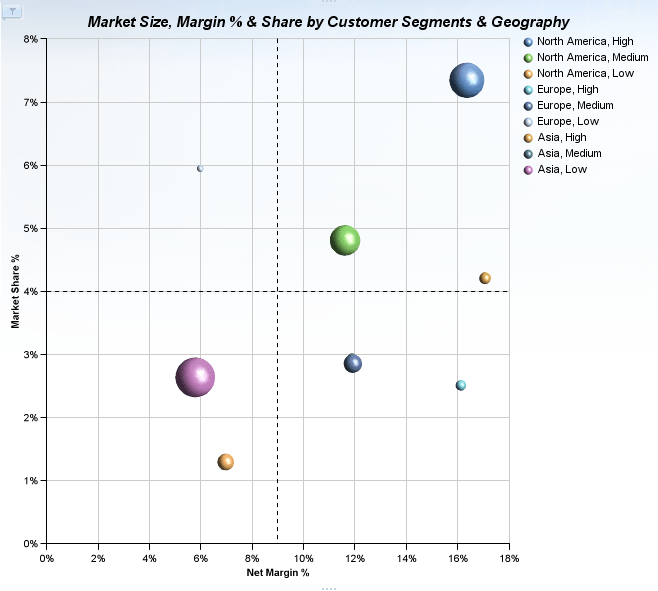Things can be complex. Especially when we look at multi-dimensional data-sets. The objective of charts is to visualize data in the most effective and easy way. You shouldn’t need a PH.D. degree to decipher a complex chart. But it happens. There are a lot of complicated and useless charts out in dashboards. And it happens more often than we think. For example: Once we reach more than 2 dimensions, many people reach out for 3D charts. Let’s say we want to analyze market size, market share & margin. Many people are tempted to simply create a 3D bar-chart like the one below:

There are a lot of obvious problems with these type of charts: The dimension have different scales and it is therefore impossible to decipher. And let’s be honest – this looks super ugly. I could not, would not make a decision based on this chart. The other option is to break this out into multiple charts. But that requires a lot of space – and space is tight in a good dashboard. Analyzing numbers would also be more difficult in that setup as we have to shift our view from one chart to the next.
THE CASE FOR BUBBLE CHARTS
There is a better way to display this type of data. My boys loves this chart type: Bubble charts (all kids love bubbles!). Bubble charts allow us to visualize three different measures at the same time. And not only that: they are easy to read and they allow us to make critical associations between these measures. Let’s have a look at an example: This is a classic bubble chart that displays three different measures: Late shipments, damaged shipments and shipping cost for different carriers. The first two measures are obvious – they are represented by the x and y axis. The shipping costs, however, are visualized via the size of the bubble.

Notice how easy it is to read this chart (which vendor has the best performance?). Depending on the problem that I am trying to solve, I could simple look at the top right area to find the black sheep that are super later and also careless. Or, I could first focus on the size of business that we do with each carrier by picking out the large bubbles. Pretty simple. Also notice how this chart allows me to combine three measures with different types scales: percentages and absolute values. The traditional 3D bar chart was useless.
THERE IS MORE
In Cognos 10, we can also turn any bubble chart into a quadrant chart. This is useful if you want to categorize your data a little further by using a common layout like it is used in a SWOT or market attractiveness analysis. Take a look at the bubble chart that we created using the data from the first Excel 3D example:

This puts the data into further context and makes it really easy for managers to spot specific key points. For example, the attractive markets (high margin & high market share) are up in the right upper corner.
Cognos 10 also allows you to hover over each bubble and you will get the numeric details behind each bubble. This makes it really easy to explore the data.

THE LIMITATIONS
As nice as the bubble charts are, they are certainly not perfect. Take a look at Chart 3 above and focus on the intersection of 11.5% Net Margin & 2% Market Share. There is a bigger bubble covering a smaller one. That can easily happen. A superficial glance over the chart can therefore be problematic because we would not notice this. Careful color choice could potentially help uncover these cases. This probably also highlights that bubble charts might not be an ideal solution for large data sets as there would be too many overlaps. But nothing is perfect, right?

Also, keep in mind that bubble charts in their pure and simple form only provide a snap-shot in time. Time-series analysis has to be done in a different manner. But the good news is that Cognos 10 offers us sliders. We can use these sliders to walk through history and easily discover changes in the data.
LAST BUT NOT LEAST
One person who has really popularized the bubble charts is scientist Hans Rosling. He literally makes data fly. If you haven’t done so, make sure to watch one of his famous TED presentations.
Take a look at bubble charts! Consider them for your next project. They are easy to understand and they allow us to make critical associations. Chances are managers who have attended business school will certainly like them. A friend of mine always says that managers are like kids. And kids like bubbles, right?
[twitter-follow screen_name=’cpapenfuss’]

Comments
One response to “Why bubble charts are cool”
Loved Hans Rosling’s TED pitch